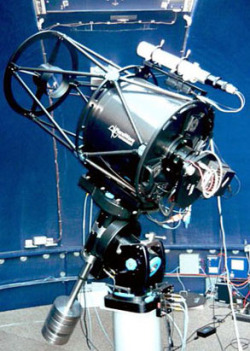Norman Falla, Asteroid Hunter
During the past two years Norman Falla, based in suburban London, England has been using iTelescope.Net in his search for new asteroids. To date his score amounts to two numbered-and-named plus another five awaiting further observations.
These asteroids were discovered using 10 inch scopes base in New Mexico and a 16 inch instrument in Australia. Recently however Norman has migrated to T11, a Planewave 20 inch CDK telescope. A 0.51m f6/8 corrected Dall-Kirkham Astrograph in New Mexico. Part of iTelescope network of remote imaging systems based in the Northern Hemisphere.
His first test of the system was to improve the orbit of one of his asteroid discoveries (2009 FC5). The weather conditions were not ideal with a combination of low temperatures and moderate wind gusts so he was pleasantly surprised to find that the instrument delivered pin-sharp images for 300-second unguided exposures.
Norman detected his asteroid, measured the position and reported the results to the Minor Planet Center. They reported back the good news that the accuracy of his measurements was acceptable and the even better news that the current magnitude of the asteroid was 22.1
The brightness of asteroids is measured in units of magnitude where the larger the number, the fainter the asteroid and the more difficult it is to detect. The significance of being able to break through the magnitude 22 barrier can best be judged by considering the current routine magnitude limits of the professional asteroid surveys who constantly monitor the sky for asteroids and comets that are on a collision course with Earth.
Currently the only survey that routinely detects asteroids significantly fainter than magnitude 22 is Pan STARRS in Hawaii. The first of four 1.8 m telescopes to be installed there is operational and can detect down to about magnitude 22.5. Although survey telescopes are generally much larger than the T11, 20" instrument and therefore potentially much more capable of detecting faint asteroids, they need to cover large areas of sky each night. They can only do this by reducing the exposure time per image and this reduces their magnitude limit.
Recent changes in the Minor Planet Center rules mean that it will be more difficult for amateur astronomers to discover asteroids. There are two advantages for amateurs in being able to break the magnitude 22 barrier.
Firstly asteroids fainter than magnitude 22 are less likely to have been observed previously and secondly faint asteroids are generally smaller and consequently more numerous than their larger, brighter counterparts.
Norman plans to carry out further observations using the 20 inch T11 scope and has set himself the target of breaking through the magnitude 22.5 barrier.
Andrew Lowe discovered information of interest to our iTelescope.Net community.
H06, the iTelescope observatory in Mayhill, New Mexico moved up to the top 50 of all observatories in asteroid discoveries and in the top 10 in asteroid research activity world wide! This is quite an accomplishment and much of it is due to Andrew's own efforts as our most prolific asteroid hunter.
